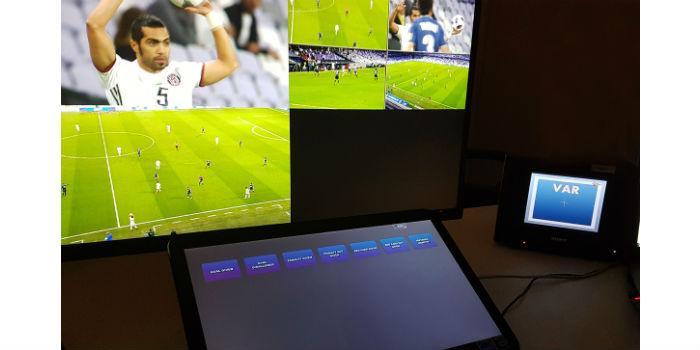 For the World Cup in Russia, FIFA officially authorized the use of the video arbitration system, known as VAR. Stadiums in Latin America are beginning to implement it.
For the World Cup in Russia, FIFA officially authorized the use of the video arbitration system, known as VAR. Stadiums in Latin America are beginning to implement it.
Richard Santa
After meeting in Bogotá last March, the FIFA Council approved the application of the latest changes to the Rules of the Game at the 2018 FIFA World Cup, among which the use of video assistants to support refereeing in matches stands out.
To understand how this system works, TVyVideo+Radio spoke with Alfredo Cabrera, Vice President of Sales for Latin America of EVS, who explained that this system uses the same number of cameras that television transmission uses and through an easy-to-use interface for the user, the referee can determine a play in case of doubt.
"Fifa does not want there to be additional cameras that are not in the VAR system, to prevent television from having an angle and video referee assistants from not. The system must have connected all the cameras that are in the field or more, never less, "added the manager.
The video arbitration system can be operated in two ways. From a place within the sports stage or from a remote location, which can be a mobile unit located just outside the stage or a production center anywhere in the world connected via fiber. The video signal is carried through a server to the operator who sends the image to the field when required, which is observed by the referee through an available monitor or tablet.
Alfredo Cabrera stressed that this is an easy-to-use system, since it only requires one or more servers depending on the number of cameras, one or more clients depending on how many visualization you have, controllers and monitors. In tied personnel, an operator with basic knowledge in video and replay and one or more trained assistant referees are required.
VAR in Russia
In the specific case of the World Cup in Russia, FIFA has determined that the video refereeing system will be available in all 64 matches. To do this, the team will assist the referee from a centralized video room located in the International Center for Radio and Television, CIRTV, in Moscow, to which the images captured in the twelve World Cup stadiums will be transmitted by fiber optics. The referee who directs each match will communicate with the VAR team using a sophisticated fibre radio system.
The VAR team will have access to 33 cameras, of which eight allow super-slow recording and four allow ultra-slow recording. In addition, they can also see the two cameras intended to determine the offside, at the exclusive disposal of the VAR team. For the knockout stage, two additional cameras will be installed that allow ultra-slow recording, one behind each goal. These cameras will also be available to the VAR team.
It is worth clarifying that the video assistant referee does not make any decision, he is limited to offering help to the referee when making the final decision, responsibility that only corresponds to the latter, in matters such as goals and infractions leading to the goal, decisions on penalties and infractions leading to a penalty, direct red cards and confusion of the identity of the offending player. The VAR information system will also be used to create graphics for the television and for the stadium video scoreboard.
When a situation arises that requires video confirmation, the referee will have a person on the field of play who will carry a Tablet in which the plays that are in doubt can be observed.
Referees at the 2018 World Cup in Russia received clear instructions on when they should accept information from the video assistant referee and when they should review video recordings next to the pitch before undertaking an action or making a decision. In addition, the FIFA Referees Commission has selected thirteen referees to act exclusively as video assistant referees in Russia.
Technology used
EVS is one of the manufacturers of broadcast technology that has developed a system to facilitate the video assistant in sports scenarios. Alfredo Cabrera, explained details of the operation Xeebra, which he stressed that it is very easy to operate and scalable for working with cameras of eight units per system.
EvS's Xeebra allows officials or video operators to easily review any number of camera angles and select the most relevant ones on the system's intuitive touchscreen or with a dedicated controller. Users can also zoom in on selected images with a simple tap-and-pinch gesture to review every angle in detail, quickly, efficiently, and in full sync.
"The idea is to bring this simplicity to football and other sports, such as basketball, volleyball, horse racing and all those that require a verification system. Xeebra is much cheaper than a replay system, which makes it very interesting for the case of Latin America, "added the EVS executive.
A high added value that the system has is that through artificial intelligence they are using the impediment line in the latest edition of the system, providing more tools to the video referee.
EXPERIENCE of VAR in Latin America
Following FIFA's decision to adopt VAR, several football leagues have implemented video refereeing systems. In the specific case of EVS technology, the leagues of Portugal, Poland, South Korea and Spain are counted. In Latin America there are also experiences, such as the matches of the semifinals and the final of the Copa Libertadores.
The EVS executive indicated that there are also football leagues in the region that are testing or waiting for decisions regarding video arbitration, as are the cases of Mexico and Brazil.
Finally, Alfredo Cabrera pointed out that "The video arbitration system is made as a tool that helps the referee in making decisions, at no time has it been considered as a system that will replace it."

























Leave your comment